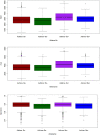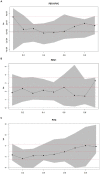The correlation between selenium intake and lung function in asthmatic people: a cross-sectional study
- PMID: 38826577
- PMCID: PMC11141543
- DOI: 10.3389/fnut.2024.1362119
The correlation between selenium intake and lung function in asthmatic people: a cross-sectional study
Abstract
Objective: This study aimed to examine the correlation between selenium intake and lung function in asthmatic people.
Methods: A total of 4,541 individuals in the US National Health and Nutrition Examination Survey (NHANES) were included in this study. Multivariate linear regression, variance inflation factor, restricted cubic splines and quantile regression were used to analyze the relationship between Se intake and lung function. We divided selenium intake into four levels based on quartiles: Q1: Se ≤ 76.75 mcg/d; Q2: 76.75-105.1 mcg/d; Q3: 105.1-137.65 mcg/d; and Q4: Se ≥137.65 mcg/d.
Results: Asthma was negatively associated with the Ratio of Forced Expiratory Volume 1st Second to Forced Vital Capacity (FEV1/FVC) (β = -0.04, 95% CI: -0.06 to -0.02) and FEV1 (β = -215, 95% CI: -340 to -90). Se intake was positively associated with Forced Expiratory Volume 1st Second (FEV1) (β =3.30 95% CI: 2.60 to 4.00) and Forced Vital Capacity (FVC) (β =4.30, 95% CI: 3.50 to 5.10). In asthmatic individuals, the positive effects of Se intake on FVC were enhanced with increasing Se intake, while the positive effects of Se intake on FEV1 varied less dramatically. High Se intake (Q4 level, above 137.65 mcg/d) improved FVC (β = 353, 95% CI: 80 to 626) and FEV1 (β = 543, 95% CI: 118 to 969) in asthmatic patients compared to low Se intake (Q1 level, below 76.75 mcg/d). At the Q2 level (76.75-105.1 mcg/d) and Q4 level (Se ≥137.65 mcg/d) of Se intake, the correlation between FEV1 and asthma disappeared.
Conclusion: Our research has revealed a positive correlation between selenium intake and lung function in asthma patients and the strength of this positive correlation is related to the amount of selenium intake. We recommend that asthma patients consume 137.65 mcg to 200 mcg of selenium daily to improve pulmonary function while avoiding the adverse effects of selenium on the human body.
Keywords: NHANES (National Health and nutrition examination survey); asthma; cross-sectional study; lung function; selenium intake.
Copyright © 2024 Jiang, Yang, Chen, Yuan, Wu, Zhang, Zhang, Yuan, Lin, Chen and Yin.
Conflict of interest statement
The authors declare that the research was conducted in the absence of any commercial or financial relationships that could be construed as a potential conflict of interest.
Figures






Similar articles
-
Association between dietary choline intake and asthma and pulmonary inflammation and lung function: NHANES analysis 2009-2018.J Health Popul Nutr. 2024 Sep 9;43(1):143. doi: 10.1186/s41043-024-00635-y. J Health Popul Nutr. 2024. PMID: 39252146 Free PMC article.
-
Moderate selenium alleviates the pulmonary function impairment induced by cadmium and lead in adults: A population-based study.Sci Total Environ. 2023 Dec 10;903:166234. doi: 10.1016/j.scitotenv.2023.166234. Epub 2023 Aug 11. Sci Total Environ. 2023. PMID: 37572899
-
Associations between metabolic score for visceral fat and adult lung functions from NHANES 2007-2012.Front Nutr. 2024 Nov 26;11:1436652. doi: 10.3389/fnut.2024.1436652. eCollection 2024. Front Nutr. 2024. PMID: 39659905 Free PMC article.
-
[Standard technical specifications for methacholine chloride (Methacholine) bronchial challenge test (2023)].Zhonghua Jie He He Hu Xi Za Zhi. 2024 Feb 12;47(2):101-119. doi: 10.3760/cma.j.cn112147-20231019-00247. Zhonghua Jie He He Hu Xi Za Zhi. 2024. PMID: 38309959 Chinese.
-
Clinical Review Report: Fluticasone Propionate (Aermony Respiclick): (Teva Canada Innovation): Indication: For the maintenance treatment of steroid-responsive bronchial asthma as prophylactic therapy in patients 12 years of age and older [Internet].Ottawa (ON): Canadian Agency for Drugs and Technologies in Health; 2019 Jan. Ottawa (ON): Canadian Agency for Drugs and Technologies in Health; 2019 Jan. PMID: 31145568 Free Books & Documents. Review.
Cited by
-
Heavy metals and their relationships with lung function and airway inflammation: insights from a population-based study.J Transl Med. 2025 Jun 11;23(1):642. doi: 10.1186/s12967-025-06538-8. J Transl Med. 2025. PMID: 40500736 Free PMC article.
-
Association of systemic immune biomarkers with metabolic dysfunction-associated steatotic liver disease: a cross-sectional study of NHANES 2007-2018.Front Nutr. 2024 Sep 4;11:1415484. doi: 10.3389/fnut.2024.1415484. eCollection 2024. Front Nutr. 2024. PMID: 39296508 Free PMC article.
-
Association between oxidative balance score and lung function and FeNO and mortality in the US population.BMC Pulm Med. 2025 Apr 8;25(1):164. doi: 10.1186/s12890-025-03626-9. BMC Pulm Med. 2025. PMID: 40200238 Free PMC article.
-
The Link Between Dysbiosis, Inflammation, Oxidative Stress, and Asthma-The Role of Probiotics, Prebiotics, and Antioxidants.Nutrients. 2024 Dec 24;17(1):16. doi: 10.3390/nu17010016. Nutrients. 2024. PMID: 39796449 Free PMC article. Review.
-
Evaluative performance of TyG-ABSI versus traditional indices in relation to cardiovascular disease and mortality: evidence from the U.S. NHANES.Cardiovasc Diabetol. 2025 Aug 21;24(1):344. doi: 10.1186/s12933-025-02902-6. Cardiovasc Diabetol. 2025. PMID: 40841630 Free PMC article.
References
LinkOut - more resources
Full Text Sources

